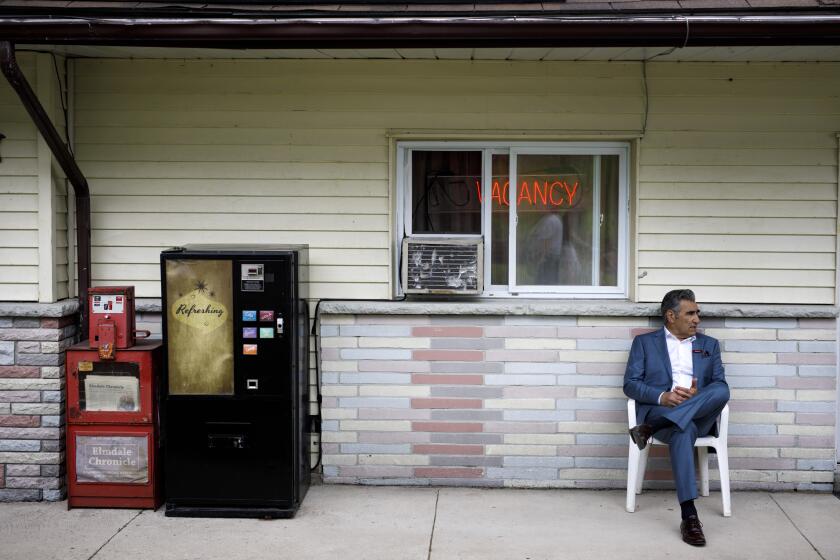Why you should watch the radical new comedy that comes with its own dark reboot
For her first series after “Schitt’s Creek” — on which she played Alexis Rose, whose loss of family fortune sent her from the jet set to the old Chevrolette set — Annie Murphy has chosen “Kevin Can F— Himself,” premiering Sunday on AMC. (It has already debuted on its premium arm, AMC+, the very existence of which may surprise you.)
On the face of it, Murphy has run as far from Alexis as possible, trading a human glitter ball for Allison, a long-suffering Worcester, Mass., housewife whose idea of a treat is Dunkin’ Donuts. Yet both Allison and Alexis are characters whose experience of life has left them remarkably naive, which is not to say untouched, and who preserve within them a sort of purity not entirely distinct from cluelessness; it has allowed them to survive a life that has not worked out as either imagined.
Season 6 of “Schitt’s Creek” promises to be emotional. The cast says filming it was plenty hard.
What makes “Kevin” unusual is that it is told in alternating modalities, as a multi-camera sitcom and a single-camera, semi-comic drama. Created by Valerie Armstrong, a writer and story editor on the great “Lodge 49,” it begins as a standard three-walled, laugh-tracked comedy, introduced in the classic manner by a bass-led musical cue. We are in a typical TV living room. (The open bathroom door, through which a toilet is nearly always visible, does feel like an editorial comment.). Kevin (Eric Peterson), a cable guy, is playing beer pong with his neighbor Neil (Alex Bonifer), a good-natured idiot who dotes on him. Kevin’s father Pete (Brian Howe) and Neil’s caustic sister Patty (Mary Hollis Inboden, a great asset) are there, lobbing in jokes. Allison — the only responsible person among them — comes in, is mocked as being no fun, and when she returns to the kitchen finds herself in a “real” place where no one is laughing.
She has no real support system. (“I had friends, right?” she will wonder to someone who knew her when.) The people around her either believe she’s lucky to have Kevin, whom she alone seems to view as a problem, or that she’s a complainer or a dreamer. “I should’ve known you’d be trouble when you tried to drop your accent in high school,” says her aunt (Jamie Denbo), with whom she works at a liquor store. She is mocked, or humored (while being mocked): “We just kind of pretend it’s happening until you come to your senses,” says Neil of her plans to move away.
It proceeds from a question all experienced television watchers will have asked themselves at one time, finding a smart, beautiful woman hitched to an immature, dumpy narcissist: “What is she doing with him?” That it shares the first two words of its title with the Kevin James sitcom “Kevin Can Wait” seems more than coincidental, as does the fact that, with his soft, droopy eyes, dark hair and extra bulk, Peterson recalls the young Jackie Gleason, whose “The Honeymooners” is the model for such mismatches. (There is a touch of Gleason’s Ralph Kramden in his delivery as well, twisted around a Massachusetts accent.)
There may be a moment in the germination of any premise or plot when the creator wonders whether she is writing a comedy or a tragedy, looks at the embryo of an idea and wonder whether it will become a person or a fish. “Kevin” might be said to embody a quantum state of entertainment, as if Schrodinger’s famous cat were not dead and alive, but Garfield on the one hand and a hungry lion on the other.
From ‘Country Comfort’ to ‘United States of Al,’ the sitcom — especially when there’s a family at the center — is still a vital place to see ourselves on TV.
The multi-camera scenes are perfectly done. There is no winking in the writing or the performances; the jokes are not bad “sitcom-style” jokes, or even jokes about bad sitcom jokes — they would pass muster in any writers room. The short-arc, episodic plotlines are textbook: moneymaking schemes, feuds between friends, a war with new neighbors, throwing a party. (It has the feel of a Fox sitcom, given the undercurrent of bitterness and absence of sentimentality; any moment in which Kevin seems ready to grant Allison a mote of appreciation is quickly undercut by his self-absorption.) At the same time, they are contextually unfunny, because you’re aware of the counter-narrative — you know what Allison is thinking. The canned laughter is laid out on a bed of dread and depression. It’s like a mainstream comedy that comes with its own dark reboot.
The dramatic scenes are shot in low or dull light, in part to set them apart from the bright, flat look of the sitcom, but also to remind us that Allison lives under a cloud. At first she believes a change of place will make her marriage sparkle again, like a new kitchen; then, as she is on the verge of effecting a dreamed-of move to a gated community down the road, she discovers that Kevin has emptied their bank account and concludes that he is the actual obstacle to her happiness. And so she decides, in a visionary moment, to kill him, setting in motion the series’ long arc and initiating a series of collateral disasters.
The story is not in itself unusual, nor is the downbeat setting. (See “Mare of Easttown.”) The phrase “She dreams of a better life” brings back nearly 88,000 hits on Google; including references to Cinderella, Booth Tarkington’s (and Katharine Hepburn’s) “Alice Adams,” the musical “Waitress,” “Waitress,” Theodore Dreiser’s “An American Tragedy,” and the Tracy Chapman song “Fast Car.” But if Allison is Cinderella, she’s going to have to off her stepmother, steal her car and drive herself to the ball. As to the potential prince, arriving in the form of Sam (Raymond Lee), an old friend/flame back in town after 15 years, he’s married and “renovating a place down near the old water tower,” which is as potent a summation of character and place as I’ve ever seen in nine words.
“Kevin” feels at once experimental and straightforward. Even though the narrative is split, it moves in a straight line. It would be a shame to have it all come down to one element being “real” and the other “imagined,” or to discover that they are both imagined, that it’s all a hallucination, or an experiment, with Allison in a padded cell, or a white room on Jupiter, or a berth in the Matrix, or that she has a brain tumor. (There are times, when the show is in transition between sitcom and drama, that she will seem to be in pain, to the accompaniment of a piercing electric whine.)
Whether you’re a newcomer or a committed fan, our week-by-week guide to HBO’s crime drama will help you understand all things “Mare.”
Allison isn’t a sitcom character who believes she is in a drama, or a character in a drama magically transported into a situation comedy. The sneaky, even radical thing about the series is how easily it gets you to accept its dueling styles without explanation. (To be sure, it isn’t the first time fiction has spoken in different voices — “Ulysses,” the novel Allison imagines herself reading over tea and a scone in her post-Kevin life, does just that, as did David Lynch’s “Twin Peaks” revival.) One could argue that the series offers a kind of aesthetic metaphor for how one person in a relationship may see it as laugh-a-minute romp, and the other a doomed drama, depending on whose needs are being met, and who is doing the meeting. The sitcom is Kevin’s territory, where his treatment of Allison is presented as awful, but hilarious; the drama belongs to Allison.
I would hesitate to deem “Kevin” a triumph or a disappointment on the basis of what’s been made available for review, but it’s conceptually ambitious and never dull. Certainly it has been intelligently conceived and acted with commitment and spirit. Taken individually, the drama might feel too familiarly dreary, the comedy too drearily familiar, but their juxtaposition and synthesis does produce something original, and definitely worth a look. And Murphy is terrific, sure in her navigation of these opposing modes, sweet and sad in a part that’s two parts in one and points to endless possibilities in parts to come.
More to Read
The complete guide to home viewing
Get Screen Gab for everything about the TV shows and streaming movies everyone’s talking about.
You may occasionally receive promotional content from the Los Angeles Times.








